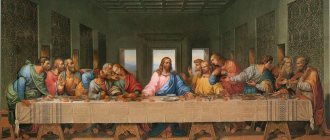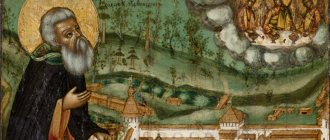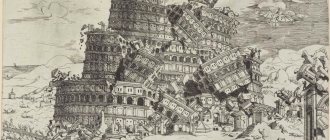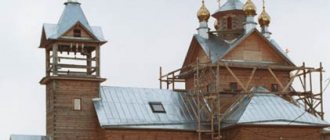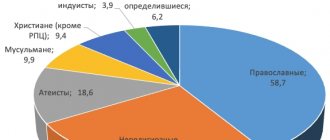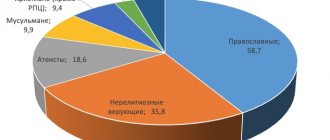Become an author
We invite you to become a participant in the distance course “Church Banner Singing”
Exhibition “Cheremshan. Return" in Bazarny Karabulak
Maltsev readings in Balakovo - new quality!
For the first time in Pakistan, the Orthodox calendar was published in Urdu
Maltsev readings in Balakovo - “atomic energy of the Old Believers”
Let's help create a community in the capital of Belarus
The Samara and Saratov diocese again found its bishop, and the revived monastery in Cheremshan found a new abbot
Under the sign of Ancient Orthodoxy: results of the Fifth Maltsev Local History Readings
Greetings from Metropolitan Cornelius to the participants of the Fifth Maltsev Local History Readings
Program of the religious procession Vereya-Borovsk 2018
The Old Believers and their contribution to the development of Russia and the Volga region will be discussed at the Local History Readings in Balakovo
Video and photos from the annual Cheremshan religious procession 2018
A chapel in the name of the prophet Elijah was consecrated in the Nikolo-Uleima convent
The Old Believer centers of Balakovo and Borovsk are restoring ties
A dome with a cross was erected on the Old Believer church in Balakovo
The Old Believer exhibition “Cheremshan. Return"
We invite you to pray a thanksgiving prayer service on December 24 in honor of the return of the Intercession of the Assumption Church in Maly Gavrikov Lane to our Church!
On December 4, Old Believers of Simferopol celebrated their patronal feast day for the first time in the recently consecrated Church of the Entry into the Church of the Blessed Virgin Mary
We invite you to participate in the Scientific and Practical Seminar “Old Believers: History, Culture and Modernity” at the MSDU on Rogozhsky
“The most important thing is what kind of Christian you become.” A youth conference was held in Kazan
At Rogozhsky, a course of public conversations is opening for those preparing for holy baptism: we invite everyone!
Construction of an Old Believer church begins in Ufa
Resolutions of the Consecrated Council of the Russian Orthodox Old Believer Church (Moscow, October 17–19, 2022)
Report of Metropolitan Cornelius to the Consecrated Council 2022
Ancient Orthodox Archdiocese: historical background
The Educational Department announces the official opening of the church website of the Russian Orthodox Old Believers Church nashavera.com
Press release: The opening ceremony of the III International Film Festival named after Savva Morozov will take place on October 1
In the ancient village of Lopatishchi, a chapel was erected in honor of the holy martyr Archpriest Avvakum
Invitation to the Shamar religious procession
“We are Russians, what a delight!”: Metropolitan Korniliy spoke at the conference of the Russkiy Mir Foundation
Division of the Church in the 17th century
The Russians firmly held the banner of Orthodoxy, so they did not need any outside help. Reforms and destruction of piety are unnecessary and meaningless. It is pointless and dangerous to bow before the Greeks, who lost confidence by signing a union with the pope during the Council of Florence in 1439. From then on, the Russians were very wary of the Greeks, as having lost piety and purity of good morals, and no longer recognized Greek authority in matters of faith, who contained such discord, unrest, and disorder in their faith if not the Greeks.
The Greek hierarchs were completely latinized, the Greeks did not have schools, they involuntarily had to study in Latin schools and academies, where they were admitted under the condition of renouncing the Greek faith. There were no printing houses, Greek books had to be printed in Latin printing houses, and, thanks to the machinations of the popes and the right eye - the Jesuits, a lot of distortions and abuses were allowed. Therefore, the Russians stopped accepting metropolitans from Constantinople, but began to elect and install themselves, and became independent from the Greeks.
The united Orthodox Church was divided.
D.E. Zhukov (1841–1903), “Dispute about faith,” 1867
Old Believers today
Now interest in the topic of Old Believers is growing; it is associated with social trends of returning to the lost values of traditional Russian culture. Indeed, the life experience of the Old Believers is an excellent example of the principle: work and pray, do good deeds. Be ready to confess and suffer for Christ.
For a long time, the Old Believers were considered a closed society, although this is partly true. Yes, this is a different world - a world of open, direct and kind, free people. The words suggest themselves:
“There’s a Russian spirit there, it smells like Russia.”
The Old Believers continue to lead the traditional way of life of an Orthodox Christian according to the traditions of the Holy Fathers. They cross themselves with the two-fingered banner, fast, and observe ancient piety. Old Believers harshly condemn drunkenness, smoking, and abortion; as a rule, this is very rare. The whole way of life, life is permeated with faith, everything with prayer, everything with the blessing of God.
Daily prayers occupy a large place in the life of an Old Believer. The daily need for prayer as a cleansing of the soul from sin is brought up from childhood. Compared to the Nikonians, the Old Believers are more active and disciplined in religious terms, strictly and more diligently fulfilling the prayer rules and religious instructions set out in the Charter. Old Believers, strong in faith, pray daily and repeatedly, following a schedule. In a religious family, prayer is read before and after every meal, in the morning and at night. And the stronger the family’s religious foundations, the more time is allocated for prayer.
Old Believers base their entire Christian life on observing religious statutes, the rules of certain rituals, and behavior on weekdays and holidays. Working on a religious holiday is considered a sin, but strict observance of fasts according to the church calendar is strict. Fasting, prayer, and work are obligatory for both elders and children. Children are taught early to perform household and church duties. Respect for elders is instilled from childhood through the blessing of an elder.
It is customary to visit the temple only in prayer clothes, Old Believers men in caftans, women in sundresses, a blouse with long sleeves and a scarf covering their shoulders. Everyone, both brothers and sisters, are friendly, responsive, and reliable in any matter.
The 21st century has brought changes to everyday life and culture. Today it is difficult to distinguish Old Believers from secular ones. In megacities, an Old Believer may not be recognized, except for especially strong zealots of the faith. Old Believers actively participate in the life of modern society; Old Believers are employed in many professions.
All Old Believers, except monks, use modern technologies without, of course, compromising their moral and religious foundations. Everything is the same as the worldly ones: Mobile communications and the Internet, their own publishing houses, magazines, books, websites and Internet forums, where there is accurate and reliable information about the life and activities of the Old Believers. This gives them the opportunity to carry out missionary activities.
Among them there are hereditary Old Believers, and there are those who sought the true faith and found it in the Old Believers. Whoever finds this, as a rule, will never leave the faith.
Prayers of the Old Believers
What prayers do Old Believers have? Yes, the same as in pre-schism times. The custom of performing prayers since the time of the apostles themselves has been passed on by Orthodox Christians from generation to generation according to the charter. Let's list the most important of them: the Jesus Prayer, the Lord's Prayer, the Publican's Prayer, the Seven Venerations, prayers before lunch, dinner, etc. and after; morning and evening prayers before going to bed. Who follows these rules completely? - the most steadfast in faith, strong in spirit! The salt of the Russian land is the Old Believers.
This obligatory home prayer is read by all Christians.
It is customary for Old Believers to perform prayers, both in church and at home, while standing; an exception is made for the sick and infirm. For them there is a relaxation according to the patristic charter.
The big beginning includes the reading of the prayer “To the Heavenly King Trisagion.” “Our Father” and ends with “Come, let us worship”
Every Old Believer’s prayer, regardless of agreement, is accompanied by prostrations to the ground and from the waist. Who canceled such bows! His reform replaced prostrations with bows from the waist. When bowing to the ground, the worshiper kneels, bows to the ground, then rises to his feet again. During prolonged prayer, special attributes are used - a handhold and a ladder.
An assistant is a rectangular rug; hands are placed on it when making prostrations. Lestovka is a type of jagged rosary, a loop-shaped ribbon with one hundred or more teeth (bobs). The ladder is usually made by believers themselves, nuns for themselves and for others, sewn from leather or thick fabric and used for counting prayers and bows. A special small ladder is sewn for children. Among the Old Believers of Tuva, two types of lestovkas are common: the lestovka of Jesus and the lestovka of the Mother of God. The first has 102 teeth, the second - 150. Both the assistant and the lestovka at the time of the schism were the property of every Orthodox Christian, but now they remain a religious attribute only of the Old Believers.
Who are the Old Believers, Orthodox, Nikonians, New Believers - what is the difference
Those who accepted Nikon's reforms were popularly called Nikonians or New Believers, and those who did not accept were called Old Believers. The Nikonians declared themselves Orthodox, the Old Believers were humiliatingly nicknamed schismatics and heretics. Who could have come up with this - the Orthodox?
Nikonians have an article: Old Believers - who are they? History and traditions | Pravmir
The dominant church, reformed by Nikon, only declared itself Orthodox; it is no longer the same church as before the schism. Only the Old Believers remained the true bearers of the pious Orthodox faith. These Christians opposed new reforms in the church. Claiming that it was founded by Christ on His commandments, “the rules of the apostle, the seven ecumenical and nine local councils of the holy fathers,” numerous hosts of martyrs, saints, saints and righteous ones.
This is enough for the spiritual salvation of a Christian, therefore every Christian who considers himself an Orthodox Christian should treat the new reforms as errors and heresies. According to the logic of the reformers, the world is changing, which means the church needs to be reformed. But from the creation of the world to our time, man has not changed. Man is the same, with his passions, leading to a sinful state, to destruction. Moreover, the church founded by Christ is unshakable and conservative in relation to external changes. Everything in it is given for our salvation and there is no need to invent anything new. “The gates of hell will not prevail against it.”
T.S. Yushmanova (b. 1979), “Old Believers”, 2001. Two Old Believers, Dionisy Perestoronin and Daniil Grigoriev, singing.
Old Believers, what are their goals?
The main goal of the Old Believers is the salvation of the soul and the fulfillment of the commandments of the Lord and the Patristic traditions: in this short life, to do as many godly good deeds as possible, to do to your neighbor what you want for yourself, to achieve the Kingdom of Heaven, trusting only in the mercy of God, since we are all sinners and unworthy. Only the Lord Jesus Christ is without sin. These are the main goals of any Old Believer.
For this, Forgive for Christ's sake.
Editorial Board of the site Ponomar.
Old Believers or Old Believers
The word “rite” arose in the Petrine era, from that time it began to be used among the Nikonians. So, as we already know, immediately after the split, those who did not accept the reforms are called Old Believers. And after the decree of Catherine II, the term Old Believers was officially used. People continue to call it that way to this day - Old Believers. In addition to these names, there were others, and we will consider them.
Old Believers Kerzhaks from the Kerzhenets River
Kerzhaki who is this? - Orthodox Christians, Old Believers, who preserved the faith adopted by Prince Vladimir in the 10th century from Byzantium, but fled in the 17th century from the desecration of the faith by Patriarch Nikon and his followers. The Old Believers Kerzhaks courageously and steadfastly maintained their faith in numerous hermitages located in the forests along the Kerzhenets River in the Nizhny Novgorod province. After a brutal defeat and devastation, the Old Believers scattered throughout Siberia, and subsequently throughout the entire Earth.
Who are the Kulugurs?
The word Kulugur came to Rus' along with the Greek faith, as it is found in the literature of the 11th - 14th centuries (for example, in the Izbornik of Svyatoslav of 1076 and in the Laurentian Chronicle of 1305). Used in Bolshoi Potrebnik (sheet 276). We also find in other sources that this was the name of the Fedoseevites (Old Believers, one of the agreements, we will consider later) who inhabited Kazan and the surrounding area. Kulugurs were the name given to the Bespopovtsy Old Believers in the Nizhny Novgorod region. The nickname was more common in the Volga region. In the Vladimir province of Melenkovsky district, Old Believers were also called priests.
Kulugur is a Greek word (kuluger) meaning monk, monk, used only on Mount Athos.
How did the Old Believers get this name? Yes, simple. The hermit life is known as the monastic life of the Old Believers, which rejects contacts with the “worldly”. Monastic strictness in morals and life, monastically long services, wearing strict black vestments confirm this. It was an honor to be called a kulugur. Today the word is forgotten, even the Old Believers do not use it among their brothers.
With the advent of new movements, neo-pagans and others, they began to apply the word Old Believers to themselves. Is there anywhere in the dictionary that an Old Believer is a pagan?
